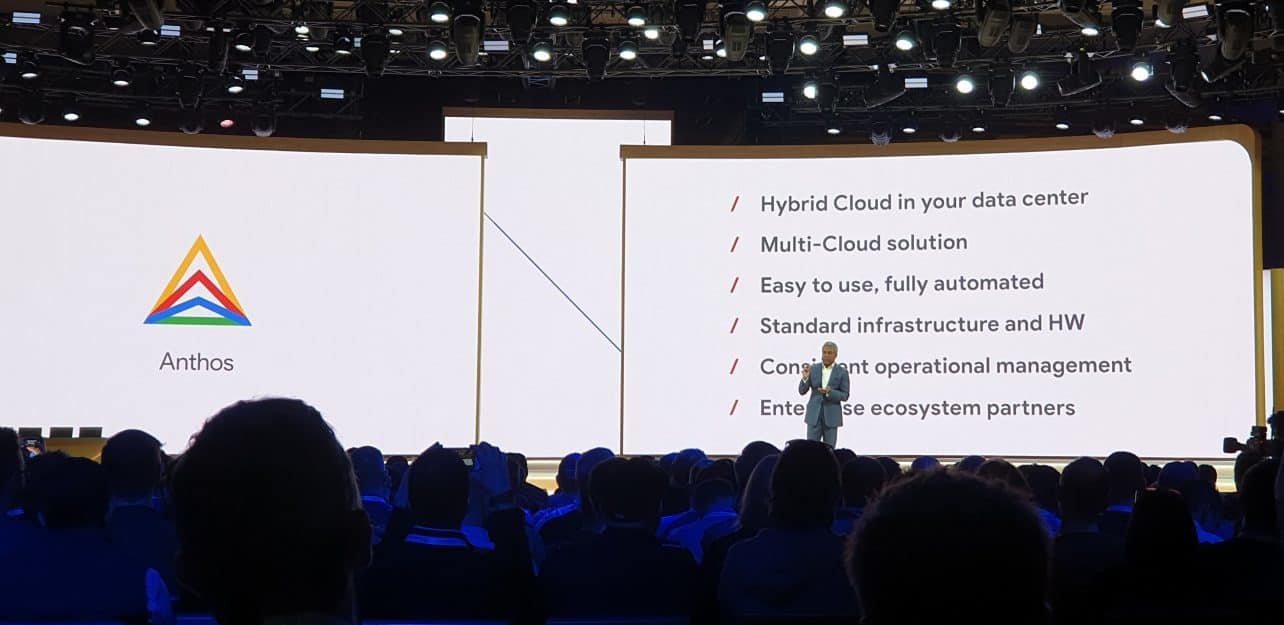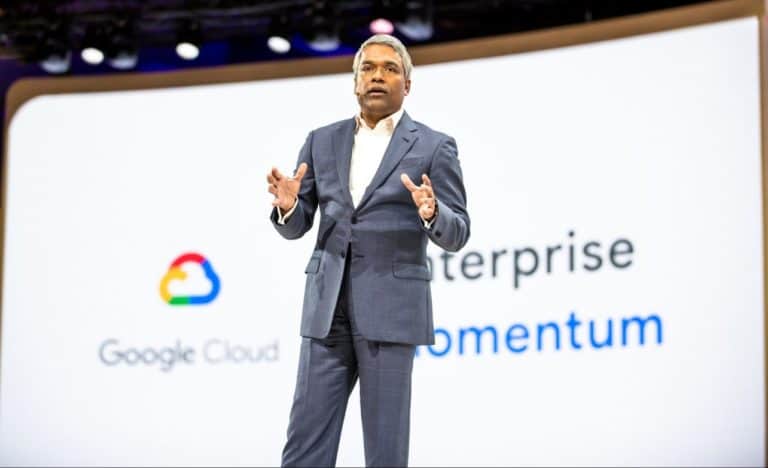Thomas Kurian is the new leader at Google Cloud. As CEO, he has to take Google Cloud to the next level. The big question is, of course, what he will do differently than his predecessors, what he has learned at Oracle and what he will probably do differently or do the same thing. Two things are immediately clear: there will be more focus on enterprise customers, and according to Kurian, the future is freedom of choice instead of lock-in.
This year, Techzine attended Google Cloud Next to see in which direction Google’s cloud service is moving. Our timing couldn’t be better, because this year there is a new man at the steering wheel for Google Cloud. Kurian left Oracle last year, more or less through the back door. According to reports, he was removed from his position by Oracle founder Larry Ellison, because Ellison did not agree with his intention to embrace other clouds, and offer more choice.
Last year we were also at Oracle Open World, where Kurian’s departure was considered a pity. We were told that three excellent replacements had already been appointed. Still, we assume that there was a bit of a turmoil at Oracle when Kurian was presented as the new CEO of Google Cloud.
One thing is certain: Google has taken the plunge. Like Amazon, the company knows how to get large groups of developers on their feet and get them interested in new Google products. In that segment, Google doesn’t fall short. It is more in the huge enterprise market where the company could take steps and learn more. This makes Kurian an excellent choice, in our view. He has gained much experience at Oracle with enterprise organizations, which means that he exactly knows what does and does not work, and where frustrations with organizations are located.

Google Cloud expanding its workforce in order to serve the enterprise market
Kurian said that in his first weeks at Google Cloud, he mainly took the time to talk to customers. He spoke to hundreds of customers to find out where their frustrations lie with Google Cloud. These are undoubtedly different frustrations than in the case of Oracle. According to Kurian, the most important answer was that Google Cloud simply employs too few people to support enterprise organizations properly. For example, there need to be people who can explain new Google technologies and how they work for the customer. In addition, Google Cloud lacks people who have knowledge of the market(s) in which customers are active, such as the retail or financial sectors.
Kurian said that if you want to be able to serve a bank properly, you also need to have enough people who know the banking industry, know what the biggest challenges are and how Google Cloud technology can help to attack those.
Therefore, Kurian’s first plan is to recruit a lot of new staff at Google Cloud. More people on sales, customer service, customer engineering and people with specific market knowledge. This should ensure that large customers can be helped much better. He didn’t want to explain exactly how many people are involved, although there is a rumor that his plan involves thousands of new employees.
This should eventually lead to more organizations considering Google Cloud. Kurian: “When we take on Amazon Web Services and Azure, we win more and more.” It’s just too rare for them to get that chance because they’re not always considered as an option.
Kurian argues for an open cloud, with standards and without lock-in
Kurian went on to say: “Google’s vision is an open cloud. A cloud in which customers have choices and with which there is no lock-in. Google Cloud has long regarded multi-cloud as a problem that needs to be solved. Customers must be provided with the ability to use technology on all hardware and all virtualization platforms, without having to adjust their workloads.”
According to Kurian, the cloud as a concept is still in its infancy. Customers still have a choice because we are still in the early stages and many companies still have to move towards the cloud. Kurian points out that 80 percent of all workloads still run on-premise and that 80 percent of Intel chips are still shipped for on-premise use. Techzine has not been able to verify these figures, but on-premise is indeed very large still. It is also a fact that Intel is selling loads of chips for the on-premise market.
According to Kurian, the winner of the cloud race is ultimately the one who can offer companies the most freedom. If you can give companies the opportunity to run their workloads on all hardware and on all virtualization platforms, then you give them the most freedom. They don’t have to decide in advance what they will run where, so whether they run their systems in the cloud or on-premise. There are also many sectors that have to deal with strict legislation. The banking sector is a good example of this. At the moment, some workloads are allowed to run in the cloud, while others are not. It could happen that next month there will be new regulation which permits fewer workloads to run in the cloud.
Banks do not want to have a contractual obligation with a cloud provider. For them, it is best if they can quickly move these workloads to their on-premise environments so that they comply with legislation. So, Google Cloud believes in an open cloud with freedom of choice. This also concerns monitoring, security and compliance. “Let’s make it the standard, then it will be much simpler,” says Kurian.
The web (HTML/Javascript/CSS) also became a standard
What Kurian is advocating still sounds a bit unreal, a completely open cloud, but he looks back to the 90s and the early 2000s. There were several web browsers, Internet Explorer, Netscape, Firefox, Safari and later Google Chrome. The big problem at the time was that each web browser had its own definition of HTML. Web developers had to optimize each website for all different browsers. When web developers think of Internet Explorer 5 and 6, their reaction will not be one of fond remembrance.
In the end, we managed to develop a single web standard that most browsers now adhere to. There is still some discussion about audio and video codecs, but developing a website has become much easier. Google has had a big hand in this with Chrome. With the Chrome browser, the company has shown that things could run better and faster. In the end, everyone changed up, and HTML5 is now the standard, combined with Javascript and CSS.
Google Cloud now wants to do the same with the whole multi-cloud and on-premise world. Companies need to be able to run their workloads anywhere without having to change anything.

Google Anthos and Google Cloud Functions as examples of open cloud
During Google Cloud Next, the first products were presented to ensure an open cloud and freedom of choice. With Google Anthos, the company has built an extension of Kubernetes. With Google Anthos, it is possible to run workloads in any cloud or even on-premise. If a cloud provider has a Kubernetes offer, Anthos can be run on it. The most important thing is that the customer does not have to adjust anything to their Anthos container, which runs on any environment. During the demo, the Google Cloud was shown, but also Amazon Web Services. You can also run Anthos on it.
It is a new approach to multi-cloud, with which customers can run their workloads independently of hardware and the virtualisation platform. With Anthos-migrate, it will also be possible to convert existing VMs to an Anthos container, so that the container can be rolled out directly in any desired environment. Kurian argues that the easier the migration to the cloud is, the more customers you will gain. That is why there is a strong focus on the proper development of Anthos-migrate: so that all types of VMs can be converted to Anthos in the future.
Google Cloud Functions: an open serverless platform based on Anthos
Serverless is another technology in the cloud that is very popular but is accompanied by more lock-in. With serverless, it is possible to automate certain tasks by means of microservices. This can be something very simple, such as scaling an image in five formats, rendering a video in certain formats, or reading a Twitter feed and using machine learning to better process and understand text. What these microservices do is start up a container, do their job, return the result to the application that summons the microservice and then destroy the container again.
This type of microservices based on serverless technology makes for much faster developing. Developers no longer have to deal with tasks that are time-consuming, but not challenging or complex. In addition, application code also remains much cleaner in this way. Many cloud providers offer a large serverless platform that enjoys great popularity.
With Google Cloud Functions, Google wants to offer an open serverless platform, with microservices which work through Anthos. This means that customers can run their serverless platforms anywhere. It doesn’t matter whether it runs on Google Cloud, AWS, Azure or on-premise. If a cloud provider somehow no longer suffices and a company wants to switch, then everything can be moved. There’s no need to modify the applications to work with another cloud.
With this, Google Cloud has now tackled the two main pain points of the multi-cloud. You have the choice of running workloads wherever you want, and the dependence (lock-in) on specific microservices on a specific cloud platform decreases.
Google Cloud also investing in database freedom
One problem remains for many enterprise organizations: the lock-in they experience with their databases. Many large companies use Oracle databases, which have been the most used databases for enterprise applications for many years. Oracle has maximally profited from this fact by charging more and more for licenses. Actually, there are only two options left: running an outdated Oracle data warehouse on-premise or running a new Oracle Autonomous Data warehouse in the Oracle Cloud. If you want to run the old database in a different cloud environment, you will have to pay considerably more in licensing costs. In this respect, Oracle is a prime example of lock-in.
A few years ago, Amazon Web Services decided to stop relying on the Oracle data warehouse. It has now designed several database technologies to offer an alternative to the Oracle version. AWS reportedly already successfully migrated itself and many customers from Oracle.
So, both Amazon and Google now have alternatives to Oracle in their portfolio. Amazon has Amazon RDS and Amazon Redshift, Google has Google Cloud SQL and Google Big Query. Whereas the Oracle data warehouse is good at processing many different types of data, Amazon chooses to develop and offer specialist database technologies. Google is now opting for a similar strategy. During Google Cloud Next, it announced a partnership with a host of open source initiatives, all of which happen to consist of different types of database applications. Google Cloud customers can order and pay for these applications directly from Google. In addition, Google offers first and second line support for these applications. If things really become too complicated, the company behind an application also provides third line support. The creators of these applications receive a fee every time Google Cloud sells them. In this way, open-source applications can also be further developed. A really excellent business model for open-source is not yet available, but this might be a good start.
There will never be a truly open-source alternative for Oracle Data warehouse. If both Amazon and Google come up with an alternative, however, that’s a good start for more freedom of choice.
Google opts for data transparency and encryption
By default, all data in the Google Cloud are encrypted. Customers can use a personal key for this so that it is no longer possible for even Google itself to view these data directly. If there are requests from a government for access to or insight into data, Google can simply refer them to the customer, because without the key, it can’t submit anything. In this way, Google Cloud complies with the law, and the customer is always responsible and involved in the retrieval of company data by governments. Customers can, therefore, fight data requests from governments at court if they deem it necessary.
Kurian announced that Google Cloud goes one step further with regard to privacy and transparency and, who has access to what. If, for whatever reason, a Google engineer needs access to a virtual machine or customer data, access must first be requested through a procedure. The customer must explicitly consent to this. Also, it will be logged exactly who has had access to what, when and where. This way, it is always clear to the customer why a Google engineer has worked on something. Of course, this is almost always on behalf of customers, because they have submitted a support ticket for a problem.
It is not the case that Google has to ask permission first in all cases. To move a virtual machine from one physical server to another, an engineer does not need access to the data. This can be done automatically with a live migration process. If something does not work properly after the migration, e.g. an application does not seem to start up, then access may be required. However, this never happens behind the customers’ back. This kind of transparency is new in the cloud world: at Amazon and Azure, they do not offer this yet.
Google Cloud is starting to take shape, and with the arrival of Kurian, large organizations will probably find it more appealing. It remains to be seen whether Google Cloud will be able to accelerate its growth.
